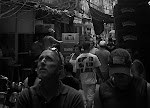
Tuesday, May 5, 2009
On the way home from Nashville I spent what seemed like 12 days in the pleasant purgatory of the Natchez Trace Parkway, a screensaver of a road if ever there was one. The same green, soft-edged, gently graded tableau appeared to unwind continually, without interruption. The only disturbances were occasional cars moving at ever-so-slightly lower or higher speeds, which required a degree of subtle interaction. (One woman did disturb the calm by slowing dramatically at the appearance of, perhaps, a buzzard, at which point I was compelled to overtake her, after which she inexplicably raced up behind me yet refused to pass; she attached herself and refused to let go, which over time became rather annoying. At one point, when she was riding close behind, like someone breathing down my neck in line, I waved at her in my rearview mirror and told her to go away: Ye of the aging and obtrusive Camry, be gone! Fortunately she soon turned on her blinker, miles before actually turning, and so disappeared into the mists of history.)
The Trace, which is devoid of unsightly billboards and the convenience of convenient stores, and where commercial vehicles are excluded while RVs are allowed, perhaps even recommended, is meant to evoke a sort of frontier-era living history exhibit within the stasis of a national park, with sometimes mind-numbing results. After a while, the appearance of an obtrusive trailer home, just over the fence at a uniformly marked historical site with a name like Birdsong’s Stand, is actually welcome, though one imagines the people in charge of the parkway are acutely disturbed by its visual presence. I liked to think of the historical site as “Birdsong’s Trailer,” because I bet the stand was closer to that than the current parkway might suggest. Also, the occasional appearance of short, marked “old trace” segments – deeply eroded trails that crisscross the more modern highway, would seem to indicate that a good bit of the hallowed original route got bulldozed for the sake of expediency. But all of that said, the Trace is lovely, particularly during the height of spring and fall, and even under normal conditions can induce a kind of cruise-controlled Zen state.
The Trace was my route of re-entry after the conclusion of the official Sultana tour, and later, in the confines of my home in Bolton, I caught up on various neglected tasks, including answering numerous interesting emails, such as one from a descendant of J. Walter Elliott who attached a letter in which he (Elliott) waxed poetic about his Sultana-related travails, which I also chronicled in my book. But as always, the Sultana emails were outpaced by the steady stream of emails from obsessive Jan-Michael Vincent fans, who apparently roam the internet 24-7, searching for any clues to his whereabouts and status. There is something both touching and alarming about the JMV fans, who clearly represent a market-in-waiting for any writer who might be inclined to enter their frenetic void.
After answering most of the emails I went on Sultana hiatus, taking a few days off before a series of radio interviews and the next actual event, a “History is Lunch” talk at the Mississippi Department of Archives and History, at noon on May 20.
No comments:
Post a Comment